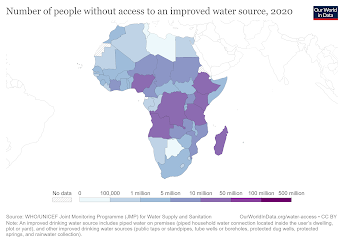World Toilet Day 2022
As
'World Toilet Day 2022' is this weekend, I thought it would be best to focus
this week's post on the importance of toilets as part of the sanitation
crisis.
World Toilet Day (WTD) has been held annually since 2013 to raise awareness for the 3.6 billion people that are living with poor quality toilets which are detrimental to their health and environment. A part of the promise of Sustainable Development Goal (SDG) 6.2 is to 'end open defecation' by 2030 (WHO). This day is dedicated towards raising awareness to the fact that the world, despite being only 8 years from 2030, is far from being on track to achieving this goal (WTD). It's crazy to think that we currently live in a world where more people have access to a phone than to a safe toilet.
The
campaign of WTD 2022 is 'Making the invisible visible', to focus on the impact
of the sanitation crisis on groundwater. Having inadequate sanitation systems
leads to human waste contaminating rivers and lakes, polluting groundwater
resources. This problem goes unseen. It's invisible because it is happening
underground, but more importantly, because it’s not directly affecting us in
the developed world! It is happening in the poor and neglected communities,
where they lack effective governance and support.
Groundwater
is the most important source of freshwater for sustaining ecosystems. It
supports industrial processes, drinking and sanitation systems, and food
production. Over 70% of the population in SSA rely on groundwater for domestic
use yet they are the ones using unimproved on-site sanitation services (OSS) (IWA).
In
Kampala, the capital and most populated city of Uganda, 92.5% of the population
relies on OSSs, and only 7.5% have access to sewage services (SFD).
Approximately 60% of the residents live in informal settlements, where the most
common source of drinking water is groundwater from on-site supply systems such
as wells and springs (SFD and IWA).
However, due to the low-quality standards of the OSSs, faecal waste and
wastewater usually goes unsafely managed due to inefficient sewers and improper
treatment. This results in public health risks and environmental pollution such
as contamination of groundwater sources.
Faecal contamination is the most widespread hazard for groundwater
contamination due to unsafe facilities. As I mentioned, groundwater supplies
are the main sources of drinking water in Kampala's informal settlements, and
with these sources being highly susceptible to contamination, the risk of
disease and illness is high. Diarrhoea kills 2,195 children every day and about
88% of diarrhoea-associated deaths are due to unsafe water, inadequate
sanitation and hygiene (Liu et al.
2012).
This
post is only a small insight into an extensive matter of the provision of
adequate toilet facilities in relation to the African Sanitation Crisis.
However, it is clear that the increased risk of groundwater contamination is a
main obstacle for meeting SDG 6. WTD is a great way to amplify and bring
attention to this agenda of safe sanitation for all, so be sure to support the
campaign this Saturday 19th November in any way you can.
Thanks
for reading, be sure to come back next week.





Your post demonstrates a reasonable grasp of water and sanitation issues in Africa, especially the challenges of toilet provision and groundwater contamination, which you have presented with engagement with relevant literature. In a subsequent post, it will be good to illustrate the issues of water contamination from humans and animals with a case study.
ReplyDelete